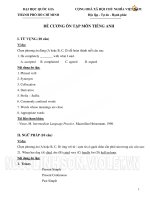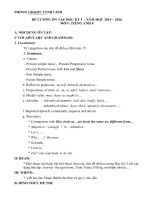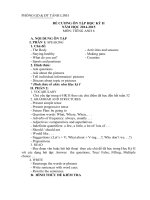ĐỀ CƯƠNG ÔN TẬP MÔN TIẾNG ANH docx
Bạn đang xem bản rút gọn của tài liệu. Xem và tải ngay bản đầy đủ của tài liệu tại đây (1.4 MB, 13 trang )
ĐẠI HỌC QUỐC GIA
CỘNG HOÀ XÃ HỘI CHỦ NGHĨA VIỆT NAM
THÀNH PHỐ HỒ CHÍ MINH
Độc lập - Tự do - Hạnh phúc
ĐỀ CƯƠNG ÔN TẬP MÔN TIẾNG ANH
I. TỪ VỰNG (10 câu)
Ví dụ:
Chọn phương án đúng (A hoặc B, C, D) để hoàn thành mỗi câu sau:
1. He completely ________ with what I said.
A. accepted
B. complained
C. agreed
D. argued
Nội dung ôn tập:
1. Phrasal verb
2. Synonym
3. Collocation
4. Derivative
5. Prefix – Suffix
6. Commonly confused words
7. Words whose meanings are close
8. Appropriate words
Tài liệu tham khảo:
- Vince, M. Intermediate Language Practice. Macmillan Heinemann, 1998.
II. NGỮ PHÁP (10 câu)
Ví dụ:
Chọn phương án (A hoặc B, C, D) ứng với từ / cụm từ có gạch chân cần phải sửa trong các câu sau:
21. When her dog (A) died, she (B) cried very (C) hardly for (D) half an hour.
Nội dung ôn tập:
1. Tenses
Present Simple
Present Continuous
Past Simple
1
Past Continuous
Present Perfect
Present Perfect Continuous
Past Simple
Past Perfect
Past Perfect Continuous
Future Simple
Future Perfect
Future Perfect Continuous
Future Continuous
Be going to …
Non – Progressive Verbs
2. Modals
Can / could & is / was able to
Could do & could have done
Must & Can’t
May Vs Might (may/ might go /be going)
Must Vs Have to
Must / mustn’t / needn’t
Must Vs have got to
Should (= use of subjunctive) if… should
3. Gerunds
Object of verbs
V + O + gerund
- used after prepositions
Used of “for + Ving. / Expressions + ING form
4. Infinitives
Object of verbs
Different uses of to – infinitive
WH + to infinitive
V + Object + ing
2
* Different meanings between
V + Ob – infinitive / gerund
(Ex remember to do / doing)
5. Nouns
Count Nouns & Uncount Nouns
Agreement
Compound Nouns
Possessive Case vs of + noun
Noun vs Gerund
(Education vs educating)
The + adj (generic sense)
6. Pronouns
Personal pronouns
Reflexive pronouns
Possessive pronouns
Demonstrative pronouns
Definite pronouns
Indefinite pronouns
Relative pronouns
Agreement pronouns
7. Adjectives
- Comparison
- ING vs ED Adj
- Positions
- Used after linking verbs
- Verbs + O + Adj
8. Adverb
- Comparison
- Positions
- Commonly confused adverbs
(hard vs hardy
close vs closely …)
3
Intensifying adverbs
9. Articles
The indefinite articles a/an and the definite article the
Use of the articles a / an with countable nouns
Use of the with uncountable nouns
The before names of places
Zero article
10. Passive
Passive verb forms
Verbs not used in the passive (be died …)
It is said / known …
He is said / known + to infinitive
Passive after NEED
Causative:
Have sth done
Have sb do
Get sth done
Get sb to do …
11. Present Participle
Present Participles vs Past Part.
Uses of ING – clauses
Participles after conjunctions and prepositions
Participle clauses with their own subjects
Misrelated participles
12. Past Participle
ED – participles vs Simple Past
ED – clauses
Participle clauses with their own subjects
Misrelated participles
13. Expressing wishes
I wish I …
It’s time …
4
If only
14. Conditionals
Type 1, 2, 3
Implied Conditionals
If … not & Unless
15. Quantifiers & Determiners
Some Vs Any
No / none / any
Much /many / little / few / a lot / plenty
All / all of; most / most of; no / none of
Both / both of; either / either of; neither / neither of
Every / all / whole
Each / every
16. Parallel Structure
17. Conjunctions
Sentence punctuation
Wrong use of conjunctions
Conjunctions vs conjunctive adverbs
18. Prepositions
At / on / in (time)
For, during and while
By and until
By the time…
In / at / on (position)
Noun + preposition
Preposition + noun
Adjective + preposition
Verb + preposition
Verb + object + preposition
19. Commonly confused words and expressions
5
as vs like
used to vs be used to
forms of OTHER
most / almost / mostly …
there is vs it is
Tài liệu tham khảo:
Azar, B.S. Understanding and Using English Grammar. Prentice Hall Regents, 1989.
Murphy, R. English Grammar in Use. Cambridge University Press, 1985.
III. PHẦN TRẮC NGHIỆM ĐIỀN TỪ (15 câu)
Phần trắc nghiệm điền từ gồm 1 đoạn văn khoảng 150-200 từ, có 15 khoảng trống, mỗi
khoảng trống có 4 từ đề nghị (A,B, C. D) để thí sinh lựa chọn. Đoạn văn có chủ đề thuộc kiến
thức phổ thơng trong các lãnh vực xã hội, kinh tế, gia đình, giải trí, giáo dục, văn hóa, các
ngành khoa học…, có cấu trúc câu và từ vựng ở trình độ trung cấp (intermediate level). Phần
này nhằm mục đích kiểm tra kỹ năng sử dụng từ vựng theo yêu cầu của văn cảnh., chọn từ có
nghĩa phù hợp với văn cảnh, lựa chọn từ kết nối văn bản cho phù hợp với cách phát triển ý
tưởng của đoạn văn.
Ví dụ:
Đọc kỹ đoạn văn sau và chọn phương án đúng (A hoặc B, C, D) cho mỗi chỗ trống từ câu 21
đến câu 35:
Chess, often referred to as the Royal Game, is the oldest of all (21) ….. games which do not
contain an element of (22) ……
The origins of chess are uncertain, (23) ….. there are a number of legends regarding its
invention. One story (24) …..that it was King Solomon who invented chess, another that it was
the Greek god Hermes, and yet another that the Chinese mandarin Han-Sing was (25) …..for its
creation. (26) …..….., chess almost certainly originated in India in the sixth or seventh century
6
AD. The game’s (27) …..then spread quickly through Persia (now (28) …..as Iran) and from
there came to Europe. The first documented (29) …..to chess in literature is in a Persian
romance which was written about 600 AD.
It is (30) …..the work ‘chess’ comes from ‘shah’, the Persian word for ‘king’ and that
‘checkmate’ , the game’s winning (31) ….., comes from phrase ‘shah mat’, (32) ….. ‘the king
is dead’.
The rules and pieces used in the game have (33) …..changes over the centuries. Modern chess
(34) …..much to the Spaniard Ruy Lopez de Segura, who in 1561 wrote the first book on how
to play the game. In it, he introduced the concept of ‘castling’, which had not been part of the
game (35) ………. then.
21. A board
B table
C panel
D top
22. A chance
B opportunity
C possibility
D probability
23. A despite
B nevertheless
C although
D however
24. A reads
B tells
C says
D writes
25. A reliable
B responsible
C dependable
D trustworthy
26. A In fact
B Obviously
C Moreover
D In general
27. A celebrity
B knowledge
C popularity
D movement
28. A called
B known
C referred
D stated
29. A reference
B mention
C appeal
D indication
30. A believed
B imagined
C held
D taken
31. A place
B stand
C go
D move
32. A representing B suggesting
C intending
D meaning
33. A underdone
B undergone
C overseen
D overtaken
34. A borrows
B lends
C owes
D pays
35. A before
B until
C after
D since
Tài liệu tham khảo:
-
Vince, M. Intermediate Language Practice. Macmillan Heinemann, 1998.
IV. ĐỌC HIỂU (15 câu)
7
Phần trắc nghiệm đọc hiểu gồm 3 đoạn văn, mỗi đoạn văn khoảng 150-200 từ. Cuối mỗi đoạn
văn có 5 câu hỏi, mỗi câu hỏi có 4 phương án chọn lựa (A, B, C. D). Các đoạn văn có chủ đề
thuộc kiến thức phổ thông trong các lãnh vực xã hội, kinh tế, gia đình, giải trí, giáo dục, văn
hóa, các ngành khoa học…, có cấu trúc câu và từ vựng ở trình độ trung cấp (intermediate
level). Phần này nhằm mục đích kiểm tra các kỹ năng sau: xác định ý chính, tìm chi tiết, suy ý,
nhận dạng cấu trúc văn bản.
Ví dụ:
Đọc kỹ đoạn văn sau và chọn phương án đúng (A hoặc B, C, D) cho mỗi câu từ 36 đến 40:
Dragons
This gigantic animal has the skin of a reptile, the body of an elephant, the head of a horse, and
the tail of a lizard. Among its many other charms, it breathes fire. It's not your average
household pet, but perhaps it should be. Some cultures think a dragon is a wise creature that
brings good luck. Others think it is a dreadful monster that destroys things.
Dragons are important in the myths of many Asian countries. They are wise and powerful
creatures. They are associated with the gods and the emperors. They can give advice, and they
represent good luck. However, they can also become angry when people don't respect them.
Then, they can become destructive. Dragons might cause big storms or damage people's
houses. It is important to treat dragons well to prevent their anger.
In myths of western countries, dragons are powerful, magical creatures, but they aren't usually
good. In many stories they are evil creatures, and people fear them. They are large animals that
resemble scary snakes with legs. They breathe fire. People don't try to treat dragons well; they
try to kill them.
In some stories dragons are good and wise. In others they are evil monsters. Whether a
dragon is good or evil, it is always a symbol of strength and magic. Long ago, some
superstitious people believed myths that dragons' blood could protect them from
wounds. Some also believed that if they drank dragons' blood, they would be able to
understand the speech of animals. In the myths of Asia and the West, dragons are powerful and
magical creatures.
(MAIN IDEA)
36. What is this passage mainly about?
8
A. A creature in myths
B. An Asian legend
C. Methods of magic
D. Types of reptiles
(DETAIL)
37. In Asia, what do dragons represent?
A. Evil B. Luck C. Fear D. Pets
38. In western myths, how do people treat dragons?
A. They give advice to dragons.
B. They burn dragons with fire.
C. They try to kill dragons.
D. They damage dragons' houses.
(INFERENCE)
39. What do some myths say about dragons' blood?
A. It is magical.
B. It is poisonous.
C. It is destructive.
D. It is delicious.
(TEXT ORGANIZATION)
40. Which paragraph is about dragon myths in the West?
A. The first paragraph
B. The second paragraph
C. The third paragraph
D. The fourth paragraph
Tài liệu tham khảo:
Xem phần hướng dẫn luyện kỹ năng đọc hiểu trong các sách TOEFL
9
V. CẤU TRÚC CÂU (20 câu)
Phần này gồm 20 mục với các câu có cấu trúc và từ vựng ở trình độ trung cấp (intermediate
level). Mỗi mục có 4 phương án (A, B, C. D) để thí sinh lựa chọn. Phần này chia làm hai nhóm
câu: 1) theo dạng Sentence Transformation; 2) theo dạng Sentence Building.
Nhóm 1 (Sentence Transformation) gồm 10 mục. Mỗi mục có 1 câu dẫn với cấu trúc và từ
vựng ở trình độ trung cấp (intermediate level). Tiếp theo đó là 4 phương án dưới hình thức câu
hoàn chỉnh đánh dấu A, B, C, và D. Trong 4 phương án này chỉ có 1 phương án chứa cấu trúc
câu được chuyển đổi mang nội dung ý nghĩa tương tự như câu dẫn.
Nhóm 2 (Sentence Building) gồm 10 mục. Mỗi mục có 4 phương án là các câu hoàn chỉnh
đánh dấu A, B, C, và D được tạo thành trên cơ sở một số từ gợi ý đơn lẻ. Thí sinh sẽ chọn
phương án hợp lý nhất về mặt ý nghĩa và hoàn chỉnh nhất về mặt ngữ pháp.
Ví dụ:
Chọn phương án (A hoặc B, C, D) ứng với câu có nghĩa gần nhất với mỗi câu cho sẵn sau đây:
51. The children couldn’t go swimming because the sea was too rough
A. The children were not calm enough to swim in the sea.
B. The sea was rough enough for the children to swim in.
C. The sea was too rough for the children to go swimming.
D. The sea was too rough to the children’s swimming.
Chọn phương án (A hoặc B, C, D) ứng với câu tốt nhất được tạo ra bằng những từ cho sẵn sau:
61. opinion / election / fair
A. My opinion was fair about the election
B. In my opinion, I think the election was fair.
C. According to my opinion, the election was fair.
D. In my opinion, the election was fair.
Nội dung ôn tập:
SENTENCE TRANSFORMATION
1.
-ER…..THAN
MORE…..THAN
(NOT) AS/SO……AS
10
2. a
SO + ADJ + THAT
ADJ + ENOUGH +
( FOR ..) + TO-INF
SUCH + (AN/AN + Adj+N) + THAT
SUCH + (A/AN + ADJ) + N + THAT
2. b
TOO + ADJ + FOR ...+ TO-INF
ADJ + ENOUGH + FOR ... + TO-INF
SO + ADJ + THAT
3.
IT + BE + ADJ + TO INF...
4.
HAD BETTER
+ V
HAD BETTER NOT + V
ADVISE + TO V
ADVISE + NOT TO V
Simple Past Tense used with AGO
Present Perfect + SINCE / FOR
5.
6.
DIRECT SPEECH
TO INF + BE + ADJ
INDIRECT SPEECH
PRESENT SITUATION
7.
8.
9.
10.
11.
SENTENCE IN
PRESENT UNREAL CONDITION
IF
PAST UNREAL CONDITION
PAST SITUATION
UNLESS
IF .... NOT
SENTENCE
- PRESENT
- PAST
IN SITUATION
HAVE
+ OBJ1 +
GET
- PAST(SUBJUNCTIVE)
- PAST PERFECT
- WOULD+V
-
ACTIVE
SENTENCE
S+
WISH +
PASSIVE
SENTENCE
Bare-INF
+ OBJ2
To-INF
S+
HAVE
+ OBJ2 + Past participle
GET
11
12.
13.
14.
15.
ALTHOUGH
THOUGH
EVEN THOUGH
BECAUSE
AS
SINCE
18.
19.
20.
21.
22.
+ NOUN/GERUND
IN SPITE OF
BECAUSE OF
+ CLAUSE
+ NOUN/GERUND
DUE TO
IT + TAKE (+ S.O) + HOW LONG + TO V
IT WAS NOT UNTIL ……….. THAT +
IT IS …… SINCE +
16.
17.
DESPITE
+ CLAUSE
DIRECT QUESTIONS
S +
S
+
V …….
V(Past)
INDIRECT QUESTIONS
THE + COMPARATIVE + S + V , THE + COMPARATIVE
WHY DON’T YOU + V...?
+ S + V
S + SUGGESTED THAT + S + (SHOULD) Vbare + ....
Simple Past with OFTEN,
COMPOUND SENTENCES
NOT ONLY ... BUT
USED TO
+V
EITHER ... OR
NEITHER ... NOR
BOTH ... AND
ALSO
23.
24.
CAN / COULD + V
SHOULD / OUGHT TO + V
BE ABLE TO + V
HAD BETTER + V
12
25.
LET'S + V
WHY DON'T WE + V....?
SENTENCE BUILDING
1.
Simple sentences
2.
Compound sentences
3.
Adjective clauses
4.
Adv. Clause of Time
5.
Adv. Clause of Reason
6.
Adverb Clause of Purpose
7.
Adverb Clause of Manner
8.
Noun Clause with Wh-Words
9.
Noun Clause with Whether /If
10.
Sequence of Tenses
+++++++ Nguồn: , ngày download: 19/11/2009
@, ,
,
- website đang xây dựng, cập nhật phần mềm, tài liệu cá nhân có trong q trình làm
việc, sử dụng máy tính và hỗ trợ cộng đồng:
+ Quản lý giáo dục, các hoạt động giáo dục;
+ Tin học, công nghệ thông tin;
+ Giáo trình, giáo án; đề thi, kiểm tra;
Và các nội dung khác.
@Quản trị: Trần Quốc Thành, 090 5 59 00 99
13









